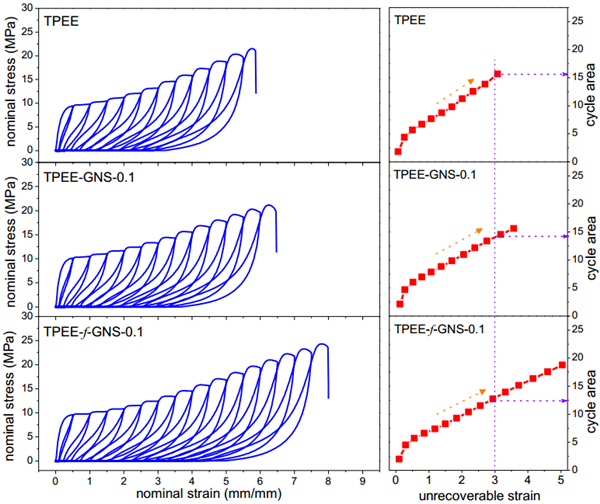Thermoplastic Polyester Elastomer Nanocomposites Filled with Graphene: Mechanical and Viscoelastic Properties
作者:Yaxin Qiu, Jun Wang, Defeng Wu, Zhifeng Wang, Ming Zhang, Ye Yao, Nengxin Wei
关键字:Polymer-matrix composites (PMCs); B. Mechanical properties; B. Creep; C. Modelling
论文来源:期刊
具体来源:Composites Science & Technology
发表时间:2016年
Composites Science & Technology, 2016, 132C, 108-115.


ABSTRACT:
Graphene nanosheets (GNS) with and without
surface functionalization were used as the reinforcements to prepared the composites
with thermoplastic polyester elastomer (TPEE) by melting mixing. The results
show that the presence of GNS improves modulus, yield
and tensile strengths of TPEE, and the surface functionalization of GNS further
improves its reinforcing effect because of enhanced interfacial interactions.
However, the elongation levels also increase in the presence of GNS, which indicates
the increased elastoplasticity and
viscoplasticity of system. This is because the discrete hard poly(butylene terephthalate) domains of TPEE are
enriched on the surface of GNS and form ‘ball bearing’ structure in composites,
leading to increased deformation ability of soft continuous poly(tetramethylene glycol) of TPEE during large-scale
deformation. Thus, the composites show more amounts of tensile cycles with
shorter true strain plateau associated with onset of chain disentangling during
cyclic tensile tests. This ‘bearing ball’ effect, however, is not evident in
small-scale viscoelastic deformation because the presence of GNS restrains
creep of TPEE. In this case, the
impeding effect of GNS on the deformation of TPEE chain
coils is the dominant role. This work provides useful information on structure
design and control of the GNS filled thermoplastic elastomer composites.
PDF DOWNLOADED:
http://www.sciencedirect.com/science/article/pii/S0266353816303049